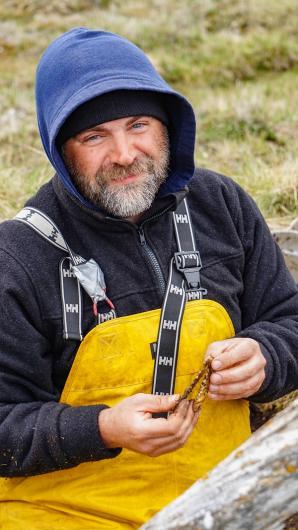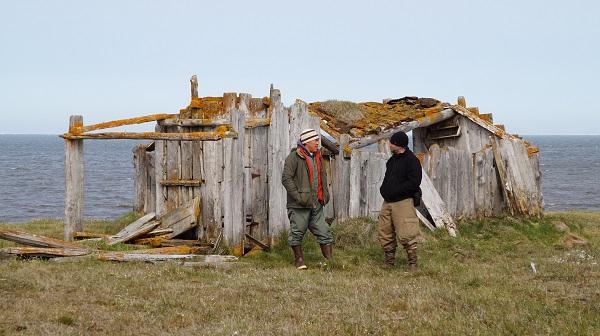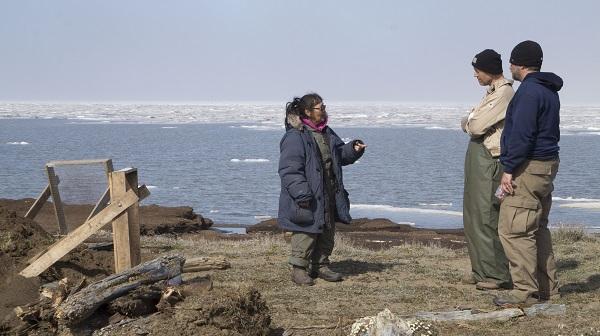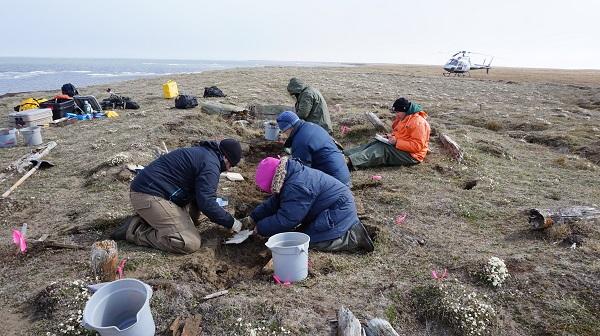You are viewing ARCHIVED content published online before January 20, 2025. Please note that this content is NOT UPDATED, and links may not work. Additionally, any previously issued diversity, equity, inclusion or gender-related guidance on this webpage should be considered rescinded. For current information, visit https://www.blm.gov/blog.
An archaeologist’s spirit drives BLM's Joe Keeney’s inclusive approach to discovering, protecting, and preserving the past
Archaeology work in 2021 is not like movies depict with action, adventure, even knife and gun fights. Back when he was a college student, BLM’s Arctic District Office Archaeologist Joe Keeney idealized the job as digging holes in exotic places. These days he describes his role with conviction.
“We’re trying to do right by the resources, the descendants, and the American public,” Keeney said.
He was recently recognized by Alaska’s Anthropological Association for his consultation with North Slope residents and conducting surveys that led to saving artifacts from cultural sites at imminent risk of being permanently destroyed by erosion exacerbated by climate change. The 2017 project involved cooperation with living descendants that have familial ties to the sites along the Beaufort Sea coast, and who were able to participate in the recovery project.

Joe Keeney holds a fox mandible excavated
for a historic Inupiaq sod house. In 2017,
Keeney and his colleagues worked with the
descendants and former inhabitants of the home
to conduct salvage surveys at eroding
northslope Iñupiaqsites. During NEPA projects,
Keeney works to build relationships and
record cultural information and historic site
locations during remote travel and consultation.
Photo by Crystal Glassburn, BLM Archaeologist.
According to Keeney, what he learned with BLM made up for the often-lacking focus on cultural resource management laws in academic programs. He said Section 106 of the National Historic Preservation Act (NHPA) is where the rubber meets the road and;leads to preserving historic properties like those found on Alaska’s North Slope. Additionally, the HPA is complimented by the National Environmental Policy Act (NEPA) when the BLM studies the potential impacts from any proposed actions, Keeney explained.
For example, a route for a planned road must be surveyed and evaluated. If an archaeological site is found in the planned route, determined to be significant, and would be affected by the road, that planned road would either need to be rerouted or the effects would need to be mitigated, which is often done through systematic excavation and data collection. Avoiding effects to historic properties can sometimes require stipulations for a permittee. Keeney said it’s preferable to avoid impacting a site altogether.
“It’s not a one size fits all thing; that’s why consultation is so important,” Keeney emphasized. “You hear from cultural resources leaders, affected tribes, local governments, and members of the public.”
Consulting with communities, tribes, and local government is also an integral part of NEPA, including public meetings and comments. Keeney will often travel to the communities potentially impacted by proposed activities to learn from the locals about nearby historical sites. That work is supported by NEPA and Section 106, as well as through the BLM’s commitment to consider traditional ecological knowledge in its science-based analyses.
“One of the most interesting things has been conversations with elders, and not so much the digging-in-the-dirt field work,” Keeney said.

Revealing an anthropologist’s spirit, he recalled interviewing people who remember living in sod houses built of driftwood and whale bone and feeling their pride in a heritage passed to them through many generations. Small but symbolic of that pride was the day, “A young man was really excited to point out the flag displayed in the Iñupiat Heritage Center in Utqiaġvik; it was his grandfather’s whaling boat flag,” Keeney said.
For Keeney, building and maintaining positive relationships with residents in the Arctic is extremely important and always a work in progress. The residents’ knowledge is crucial for helping Keeney better identify and preserve grave sites, former homes, and even favorite fishing sites, to name a few.
“There are sites on the North Slope that have faces and names and families still associated with them,” Keeney clarified. “Their former inhabitants may even still be alive.”
These facts also mean families are keenly aware of artifacts that were removed from ancestral lands in the past, regardless of the reason. While “This belongs in a museum” is shouted by a certain heroic film archaeologist, Keeney and his associates note that remains, grave goods and other culturally important items actually belong with their associated groups. The Native American Graves Protection and Repatriation Act (NAGPRA) backs up that claim.

It can be a challenge to repair broken trust, even within the archaeological community Keeney said about BLM’s role in repatriating artifacts to the communities he works with.
In cooperation with the University of Alaska Museum of the North, he recently traveled to New York to retrieve and return an extensive collection of artifacts and documents collected by archaeologist Ed Hall in the 1970’s and 1980’s. Back then, Hall worked with the United States Geological Survey to identify sites across the North Slope. Keeney said Hall made important ethnographic contributions and established some of the archaeological methods still used in the area today, like helicopter surveys. While NAGPRA may not have applied to all of Hall’s collection, Keeney said the relics are culturally significant and needed to come home.
“Cultural resource laws are really the reason we exist as a profession or have a job,” Keeney summed up.
The National Register of Historic Places requires a process for identifying and preserving historic properties with a federal undertaking, which necessitates archaeologists in both the public and private sectors.
“Through my years of experience, as an academic and with another federal agency, BLM does the best job combining cultural preservation with the applicable laws that drive the archaeological work we do. BLM’s multi-use mission really puts the NHPA to the test.”
So why doesn’t BLM share more frequently about the work Keeney and his colleagues do? Simply put, advertising it could mean divulging the locations of valuable sites and artifacts to potential looting and vandalism. A similar policy guides other BLM-permitted activities, like paleontological expeditions for dinosaur remains. While archaeology and paleontology are separate sciences, Keeney fills the role of paleontologist for the Arctic District Office too.

These preservation practices reach across BLM’s multiple use mission, even impacting other permitted groups like river rafters, campers, and hunting guides. One of the most common concerns for disturbing cultural resources is camp latrines.
“You want to make sure you’re not digging a cat hole in a several thousand-year-old tent ring,” the veteran U.S. Marine pointed out.
While you may not see their heroics on the big screen, BLM Alaska’s archaeologists are working toward a sustained, long-term, positive impact in the communities they serve by understanding cultural resource laws, improving their practice and methods of consulting, and continuing a program they can be proud of.
“The real work is understanding the laws that lead to protections for important sites, pairing it with public education, working with project proponents, and ultimately helping leaders make good land management decisions,” he said.
Roll credits…
Melinda Bolton, Public Affairs Specialist
